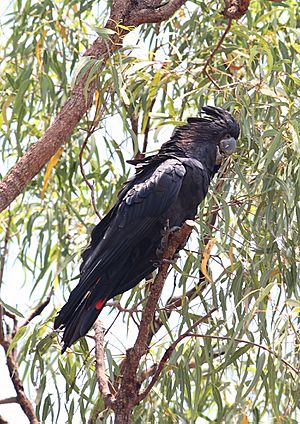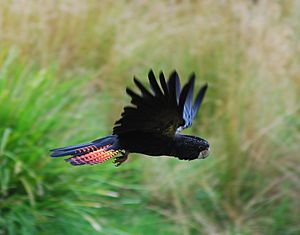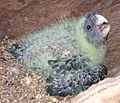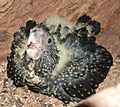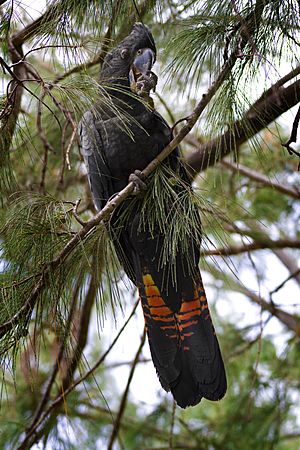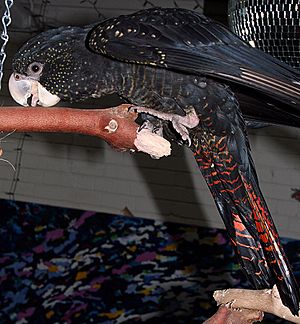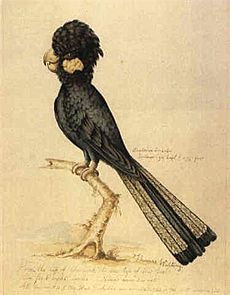Red-tailed black cockatoo facts for kids
Quick facts for kids Red-tailed black cockatoo |
|
|---|---|
 |
|
| A pair (male on left and female on right) | |
| Conservation status | |
| Scientific classification | |
| Genus: |
Calyptorhynchus
|
| Species: |
banksii
|
| Subspecies | |
|
|
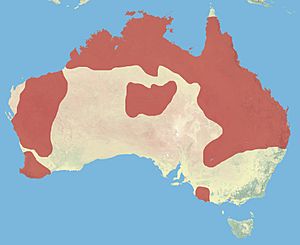 |
|
| Red-tailed black cockatoo range (in red) | |
The red-tailed black cockatoo (Calyptorhynchus banksii) is a large black cockatoo found in Australia. It is also known as the Banksian or Banks' black cockatoo. Adult males have bright red patches on their tails, which is how they got their name. These birds are more common in the drier parts of Australia.
There are five different types, or subspecies, of red-tailed black cockatoos. They mostly differ in the size of their beaks. While the northern types are common, two southern types, the forest red-tailed black cockatoo and the south-eastern red-tailed black cockatoo, are in danger.
You can often find these cockatoos in eucalyptus forests or near rivers. In northern Australia, they are often seen in large groups. They eat seeds and build their nests in tree hollows. This means they need big, old eucalyptus trees to live. In southeastern Australia, their homes are threatened by trees being cut down.
Understanding the Red-tailed Black Cockatoo
What's in a Name?
The red-tailed black cockatoo was first described by a bird expert named John Latham in 1790. He named it Psittacus banksii to honor an English plant expert, Sir Joseph Banks.
This bird was also the first bird from Eastern Australia drawn by a European artist. A female cockatoo was sketched by Banks' artist, Sydney Parkinson, in 1770.
The scientific name Calyptorhynchus comes from ancient Greek words. Calypto- means "hidden" and rhynchus means "beak." This name refers to how their beak looks.
Different Types of Red-tailed Black Cockatoos
The red-tailed black cockatoo has a close relative called the glossy black cockatoo. These two birds are different from other black cockatoos. They show clear differences between males and females. Their young also make special sounds, like a squeaking call when they want food.
Scientists have studied the DNA of cockatoos. They believe that cockatoos first appeared in Australia a very long time ago.
There are five main types (subspecies) of red-tailed black cockatoos. They are different in their size, beak shape, and the colors of the females.
- C. b. banksii is found in Queensland and northern New South Wales. It is the largest type and has a medium-sized beak.
- C. b. graptogyne is known as the south-eastern red-tailed black cockatoo. It is an endangered type found in Victoria and South Australia. It is the smallest of the five types. These birds rely on specific trees for food and nesting. Many of these trees have been cleared, and only about 500–1000 birds might be left.
- C. b. macrorhynchus is called the great-billed cockatoo. It lives across northern Australia. This type is large and has a big beak. Females of this type do not have red in their tails.
- C. b. naso is known as the forest red-tailed black cockatoo. It is found in the southwest part of Western Australia. This type has a larger bill and prefers certain types of eucalyptus trees.
- C. b. samueli lives in different areas, including parts of Western Australia, Central Australia, and New South Wales. These birds are generally smaller than C. b. banksii and have smaller beaks.
What They Look Like
Red-tailed black cockatoos are about 60 centimeters (24 inches) long. Males and females look different, which is called sexual dimorphism.
- Males are all black. They have a noticeable black crest of feathers on their head. Their beak is dark grey. Their tail is black with two bright red patches on the sides.
- Females are black with yellow-orange stripes on their tail and chest. They also have yellow to red spots on their cheeks and wings. Their beak is pale and horn-colored. Their belly feathers have fine yellow bars over a black base.
Male birds usually weigh between 670 and 920 grams (1.5–2 pounds). Females are a bit lighter, weighing 615–870 grams (1.25–1.75 pounds). Like other cockatoos, they have special feet with two toes pointing forward and two backward. This helps them hold food with one foot while standing on the other. Most black cockatoos, including these, are left-footed.
Young red-tailed black cockatoos look like females until they are about four years old. Their yellow belly feathers are paler. As males grow up, their yellow tail feathers slowly turn red. This change takes about four years.
These cockatoos can live a long time in zoos. One bird lived for over 50 years at Taronga Zoo. Another lived for over 45 years in European zoos.
Red-tailed black cockatoos make different sounds. Their contact call is a rolling, metallic krur-rr or kree. This sound can travel far and is always made while flying. Their alarm call is sharp. Males make soft growling sounds followed by a repeated kred-kred-kred-kred when they are showing off.
Where They Live
The red-tailed black cockatoo mostly lives in the drier parts of Australia. They are common in a wide band across the northern half of the country. In the south, they are found in more scattered areas.
They live in many different places. These include shrublands, grasslands, eucalyptus forests, and even thick tropical rainforests. They need large, old eucalyptus trees for nesting. The type of gum trees they use can be different depending on the area.
These cockatoos do not move far, but they do travel with the seasons in Australia. In the northern parts, they often leave humid areas during the summer wet season. In other places, they follow where their food sources are. This happens in Northern Queensland and New South Wales.
How They Behave
Red-tailed black cockatoos are active during the day. They are loud and noisy. You can often see them flying high in small groups. Sometimes they fly with other types of cockatoos. Large groups of up to 500 birds are usually only seen in the north or where there is a lot of food. Otherwise, they are quite shy around people.
In northern and central Australia, these birds might eat on the ground. However, the two southern types, graptogyne and naso, almost always stay in trees. They fly slowly with deep, strong wingbeats. This is different from the glossy black cockatoo, which has shallower wingbeats. They also often fly very high.
Reproduction and Life Cycle
When a male red-tailed black cockatoo wants to attract a female, he puffs up his crest and cheek feathers. He hides his beak, then sings and struts around. He finishes with a jump and a flash of his red tail feathers towards the female. She will often bite him back in response.
They usually breed from May to September. However, the South-eastern type nests during summer (December to February). Some types might have two sets of babies, while others only have one.
They build their nests in large, tall tree hollows. They often choose isolated trees so they can fly in and out easily. The same tree might be used for many years. The hollows can be 1 to 2 meters (3–7 feet) deep.
A female lays 1 or 2 white eggs. However, the second chick often does not survive.
What They Eat
Red-tailed black cockatoos eat many different native and introduced seeds. But their main food is eucalyptus seeds. They have a special connection with eucalyptus trees that have larger fruits. These trees vary across Australia.
The cockatoos bite off small branches with seed pods. Then they hold them with their feet while they chew and get the seeds. They leave a lot of chewed-up bits on the ground. They also eat seeds and nuts from other plants like Acacia, Allocasuarina, Banksia, Grevillea, and Hakea. They also eat berries, fruits, and various insects.
Sometimes, these cockatoos eat plants that were brought to Australia, like doublegee. They have also been known to eat wild radish, wild turnip, and melon. In some farming areas, large groups of cockatoos can damage peanut crops. They learn to cut the peanut plants and pull the peanuts out of the ground. They can also damage electrical cables on farm equipment.
Protecting the Red-tailed Black Cockatoo
The red-tailed black cockatoo is a protected bird in Australia. This means it is against the law to harm them.
Internationally, these birds are listed under CITES Appendix II. This allows some trade in live birds, but only if it does not hurt the wild populations. However, Australia has its own rules that limit exports. The C. b. graptogyne subspecies is specifically listed as endangered in Australia.
The protection status of the red-tailed black cockatoo can be different in each Australian state.
- The south-eastern red-tailed black cockatoo (C. b. graptogyne) is listed as endangered in South Australia. Even though their numbers increased to about 1500 birds in 2012, they are still in danger of disappearing.
- This same subspecies is also listed as threatened in Victoria. Plans are in place to help this bird recover.
- The red-tailed black cockatoo is listed as vulnerable in New South Wales.
Like many Australian cockatoos, the red-tailed black cockatoo is threatened by illegal bird smuggling. Because many birds die during smuggling, even more are taken from the wild than are actually sold.
There is an annual count called the Great Cocky Count. It has been held every year since 2009. This count helps track how the populations of red-tailed and other black cockatoos are changing.
Keeping Red-tailed Black Cockatoos as Pets
In the late 1990s, red-tailed black cockatoos were very expensive. Hand-raised birds can learn a few words and be very friendly. However, male birds that are hand-raised might not want to breed later.
The red-tailed black cockatoo is the most common black cockatoo kept as a pet. They can be strong and live a long time if they have enough space. Most birds in captivity have been from the C. b. banksii and C. b. samueli types.
These birds can breed easily in captivity. They can lay eggs every 3 weeks between February and November. Once a female has one egg, she usually won't lay another. An egg takes about 30 days to hatch. The young birds' eyes open around 3 weeks. Their yellow baby feathers will show black adult feathers at about 6 weeks. Young birds are ready to leave the nest after about 4 months. Both male and female young birds have the same colors as their mother. When male birds become adults (around 4 years old), they might become aggressive towards younger males. If they are in a cage, they need to be separated.
These birds have very large and strong beaks. They can easily open a Brazil nut, which usually needs a tool to crack. They can also break apart a whole coconut in about three days.
Cultural Stories
- A red-tailed black cockatoo named Karak was the official mascot for the 2006 Commonwealth Games in Melbourne. This helped raise awareness about protecting the south-eastern subspecies.
- A traditional story from western Arnhem Land tells about Black Cockatoo and her husband Crow. They were Bird-people who got sick from something that came from the sea. Fearing they would be buried, they turned into birds and flew high into the sky.
- The Tiwi people have a story that says the red-tailed black cockatoo goes with the dead to heaven.
|
See also
 In Spanish: Cacatúa colirroja para niños
In Spanish: Cacatúa colirroja para niños




